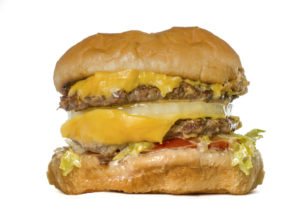
Today I want to share a bit on the perils of dining out. Over the past few decades, the most dramatic shift in our dietary habits has been the replacement of home-cooked meals with foods prepared by restaurants, especially fast food restaurants.
Not long ago, dining out was reserved for special occasions like graduations, birthdays, and anniversaries, but for many Americans, it is now a routine part of daily living. The average American consumes three burgers and four orders of fries a week from outside the home!
With over 600,000 dining establishments, largely fast food joints, available to feed us, many of which market their fare incessantly, it is no wonder that we now spend about 50% of our food budgets (up from 25% in 1970) and consume up to 40% of our calories from meals prepared by the hands and machines of others.
Tragically, it comes at a huge price. Coincident with this epic shift in dining out vs. dining at home, rates of diet-related chronic diseases including obesity, type 2 diabetes, fatty liver disease, and metabolic syndrome, have skyrocketed. Record numbers of Americans have lost their health, and healthcare spending has reached unimaginable levels that threaten our continued existence as a strong and prosperous nation.
I firmly believe that the biggest culprit is our reliance on others to provide our meals and the notoriously poor choices we tend to make in this context. In fact, there is widespread scientific consensus that dining out increases the risk of eating excess, unhealthy calories and well-conducted studies confirm it.

According to one comprehensive scientific evaluation, here is what you can expect in terms of extra calories when you choose to eat foods away from home.
That said – my next e-course is going to be focusing on getting your kitchen in order and becoming a confident, healthy cook! Welcome, The Healthy Kitchen Makeover E-Course. This course will include soup to nuts guidance on what foods to keep in, as well as out of your kitchen, the must have kitchen equipment essentials, the food ingredients you should always have on hand, amongst more – all so fast, efficient, tasty, and of course healthy meal prep is just an arm’s length away. My daughter, Liz, who is a bonafide kitchen and cooking guru will be joining me for this inspiring course. So be sure to check it out when available later this spring.
(Adult Diet Quality. ERR-90, USDA, Economic Research Service February 2010 and Food Policy, vol. 34(6))